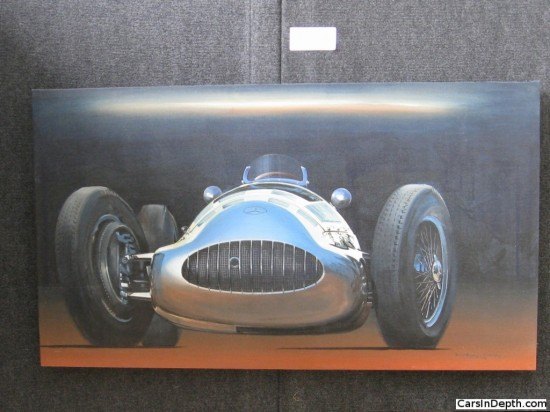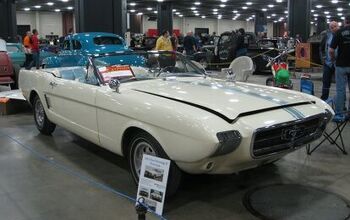Detroit Knows Art

Charles Maher, Bloomfield Hills, MI
We seem to be in a bit of a museum mood, what with Thomas Kreutzer’s report on the expanded Pierce Arrow Museum in Buffalo, NY., the continuing story about the Petersen Museum selling off part of their collection, and speculation on what will happen to the valuable art, cars and other items that belong to city-owned museums in the wake of Detroit’s filing for municipal bankruptcy. In the comment thread to our second post about the Petersen, the relationship between the world of cars and the world of fine art was raised by narcoossee, and 3Deuce27.
I suppose Detroiters are a bit touchy when it comes to things like fine art. After all, Detroit is, at heart, a factory town and proud of that fact. Our dreams are made of iron and steel, not pastel chalk and pretty paintings.
David Chapple, Detroit, MI
Folks from outside the region think of Detroit that way as well. Someone once asked me, in the wake of Chrysler’s Imported From Detroit ad campaign, “Just what would Detroiters know about style?”. I simply pointed out that Minoru Yamasaki, who designed the original World Trade Center towers, and two other of the 20th century’s greatest architects, Albert Kahn and Eero Saarinen, didn’t just design buildings for Detroit, they designed buildings in Detroit. All three of their firms were based in the Detroit area. Saarinen’s onetime business partner, the great designer Charles Eames and Eames’ wife Ray, also spent formative years in the Motor City.
Gerald Freeman, South Lyon, MI
Today, car enthusiasts and collectors are pushing the art world to embrace the art that goes into making and selling cars along with some cars themselves as examples of fine art. Frederic Sharf’s book on styling studio art, Future Retro, and the related show at Boston’s Museum of Fine Art, are examples of that effort. Getting that recognition for the artistic talent involved in making cars is one of the rationales for the Petersen’s sell off, the museum’s management says that they want it to be one of the best art and design museums in the world.
Steve Purdy, Williamston, MI
It may have taken some time and effort to get the general art world to take notice but the local creative community in Detroit has appreciated the contributions to the art world by the automotive industry for over a century, and not just because captains of Detroit industry donated a lot of art to the Detroit Institute of Arts. The institution that is now Detroit’s College for Creative Studies, which continues to train a good fraction of the people who design cars around the world, started out in 1906 as the Detroit Society of Arts and Crafts, with Kahn, whose factory designs changed the auto industry, as one of the founding members. In the more than a century since then, many of the Society’s and CCS’s instructors and faculty have been working designers in the auto industry. Perhaps even more than the DSAC/CCS, Detroit’s Scarab Club, a hangout for artists and art lovers, has been the nexus of Detroit’s fine art and automotive worlds.
Michael Goettner, Sylvania, OH
From the Scarab Club’s website:
The Scarab Club was founded in 1907 by a group of artists and art lovers who enjoyed meeting regularly to discuss art and socialize. The desire to form an arts organization in Detroit during the first third of the 20th century was partially intertwined with the birth of automotive design and the evolution of advertising art inspired by the burgeoning automobile industry. Although generally viewed as a heavily industrial city, Detroit’s artistic community thrived from the success of the automobile.
Many of the original founding members of the Scarab Club consisted of automotive designers, advertising illustrators, graphic artists, photographers, architects, and automobile company owners. Scarab Club members inspired each others’ artistic spirit by entering their artwork in the Annual Exhibition of Michigan Artists held at the Detroit Institute of Arts under the auspices of the Scarab Club from 1911 to 1928 and the DIA from 1929 to 1974.
Clark Gordon, Detroit, MI
Anyhow, with all this talk of art, cars and car art, I remembered that for the past couple of years, a group of artists, painters, photographers and sculptors, has put together exhibitions called Detroit Knows Art in downtown Detroit office building lobbies. This is as good an excuse as any to post the photos that I took of the 2012 Detroit Knows Cars exhibit at the Chase Tower. Keeping with this post’s theme of the nexus between art and automobiles, among the artists whose work was on display were retired Ford designer, Howard “Buck” Mook, who is absolutely proud of the 1974 Mustang II because it was one of the best selling Mustangs ever, and Camilo Pardo, who is so proud of the Ford GT that he designed he’s done a series of fine art paintings of the car. Other participating artists were Alex Buchan, David Chapple, Gerald Freeman, Michael Goettner, Clark Gordon, Jim Haefner, Tom Hale, Jay Koka, Charles Maher, and Steve Purdy.
Jim Haefner, Troy, MI
Tom Hale, Northville, MI
Jay Koka, Toronto, ON
Buck Mook, West Bloomfield, MI

Ronnie Schreiber edits Cars In Depth, the original 3D car site.
More by Ronnie Schreiber
Latest Car Reviews
Read moreLatest Product Reviews
Read moreRecent Comments
- ToolGuy TG likes price reductions.
- ToolGuy I could go for a Mustang with a Subaru powertrain. (Maybe some additional ground clearance.)
- ToolGuy Does Tim Healey care about TTAC? 😉
- ToolGuy I am slashing my food budget by 1%.
- ToolGuy TG grows skeptical about his government protecting him from bad decisions.


































































































































































Comments
Join the conversation
"Buck Mook"! That's the coolest name I ever heard.
There are Yamasaki, Saarinen, and Kahn houses in my neighborhood. The house that is Saarinen's first independent commission is down the street from me. The original plans are in the Cranbrook Institue of Art and Science.